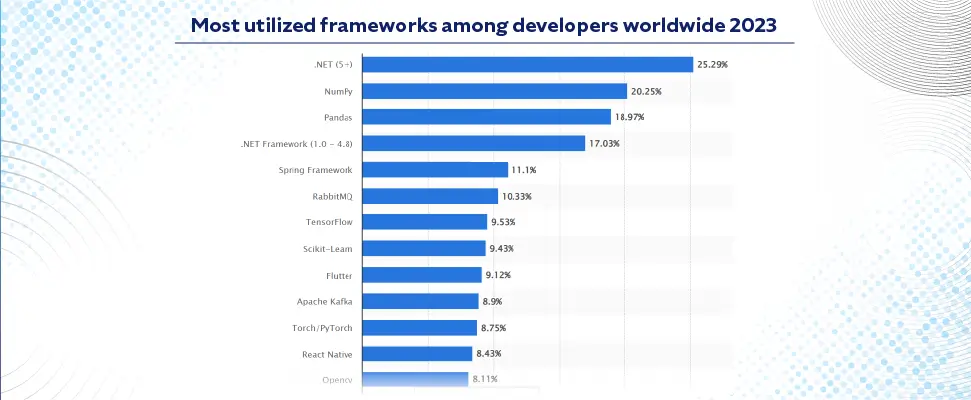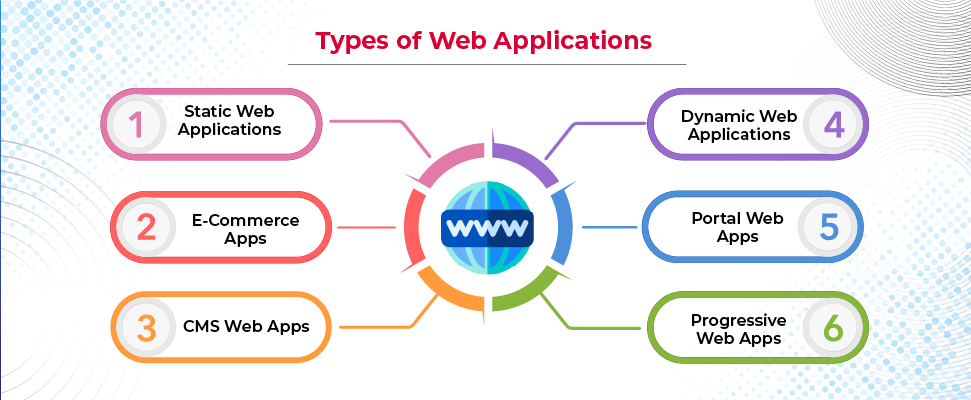Table of Contents
ToggleIntroduction
Microsoft’s introduction of the .NET Framework in 2002 had an enormous impact on the software development industry. Undoubtedly, it simplified development by enabling cross-language integration on a single platform. In a way, one can say that .NET is a comfort zone for developers.
Finding your comfort zone is a good thing, but staying there? You may want to think about that again if growth is your goal. The software industry is changing at an unprecedented rate. As a result, if you are a software business owner or a developer, you ought to stay updated with the current trends, or it could slow down your growth in the industry.
The .NET ecosystem built by Microsoft also updates its technology periodically so that the platform continues to be smarter, more reliable, and more scalable. In this blog, we will look at the top 10 .NET development trends that dominate 2023.
The .NET Framework
The .NET Framework is a free, open-source software development framework. It provides software developers with a standard platform to build applications for mobile, web and desktop. Moreover, the framework is compatible with a variety of programming languages, such as C#, F#, and Visual Basic. This enables the creation of apps that can be integrated with popular products. A Statista study indicates that the .NET (5+) Framework is the most used framework. Around 25.3 percent of respondents in a Statista survey used the .NET (5+) Framework in 2022, while around 17 percent of respondents used the .NET Framework.

Why do developers love .Net?
- The .NET Framework supports more than 60 languages, which gives developers the freedom to choose the language that best suits their project.
- The CLR (Common Language Runtime), which is one of the main components of the .NET Framework, allows developers to execute code written in any supported language.
- The .NET Framework Class Library (FCL) offers built-in functions that developers can use to build different apps.
- .NET Framework comes with tools, libraries, and open-community support that helps create applications for desktop, web, mobile, and gaming.
- The framework is known to have regular security checkups and bug fixes that help developers build reliable and robust applications across different projects.
- The .NET Framework can integrate with other Microsoft technologies, making it easier to build apps that can seamlessly integrate with Microsoft products.

Don't miss out on your chance to work with the best
apply for top global job opportunities today!
Top .NET Trends to Dominate in 2023
Here is a quick look at 10 trends that are expected to dominate 2023.
- .NET for IoT Networks
- ASP.NET Core Blazor Progressive Web Application (PWA)
- .NET Game Development
- Xamarin .NET Development
- ML.NET
- Usage of .NET MAUI for Native Apps
- Web-Based Apps Using .NET
- Advancement in .NET Security
- Docker Support for ASP.NET Core PWA
- Azure Cloud For .NET Applications
1. .NET for IoT Networks
The Internet of Things (IoT) makes everyday devices smart by connecting them to the Internet. A smart home with devices like light and heat sensors, motion detection cameras, and smart appliances is a common example of IoT. These devices use the Internet to collect data and act on them. .NET API is broadly used by developers to build IoT applications. It gives developers access to the framework’s extensive libraries and support, which can be used to build apps for IoT devices.
2. ASP.NET Core Blazor Progressive Web Application (PWA)

The Blazor framework by Microsoft allows developers to use C# and .NET to create interactive web apps. This means that they don’t have to rely only on JavaScript to make progressive web applications (PWA). This is important in 2023 and further because PWA apps consume fewer resources but guarantee a high performance. This ensures better user satisfaction at a low cost.
3. .NET Game Development
A report by Statista states that the Video Games market is projected to reach a market volume of US$363.20 billion by 2027. With .NET, game developers can build lightweight games with high-end graphics for platforms including PlayStation, Windows, and Xbox. in addition, it allows you to make graphics for Virtual and Augmented Reality-based games that provide a native app experience to users.
4. Xamarin .NET Development
Developers integrate Xamarin with .NET to build modern, high-performing applications for OS, Android, and Windows. Xamarin is a free, open-source and cross-platform where you can use C# to create native mobile apps for enterprise companies and software developers. Apps created with Xamarin offer great user experiences as they work exactly how users anticipate.
5. ML.NET

A new framework by Microsoft, ML.NET, allows machine learning to be integrated into .NET applications. ML.NET is also free and an open-source cross platform, and you can use it to create custom machine-learning models using C# and F# in the .NET ecosystem. ML.NET’s built-in AI models can be used for voice, emotion, and sentiment recognition and detection. ML.NET allows developers to create .NET applications that can learn customer behaviors, improve user experiences, predict growth, forecast sales, and detect fraud.
6. Usage of .NET MAUI for Native Apps
To every developer racing against tight deadlines set by their clients, .NET MAUI is a lifesaver. The high-quality technology of .NET MAUI can be leveraged to create native applications on a single codebase with C#. .NET MAUI allows developers to do many things, including sharing single and multiple files between devices, using text-to-speech modules, and protecting data using the key-value combination technique. It also lets you perform real-time network, bandwidth, and latency analysis.
7. Web-Based Apps Using .NET
The reason why .NET shows much–projected growth in the coming years is that it is cross-platform, scalable, stable, secure, and modern. Its ability to run a single codebase across major operating systems makes it a top choice for businesses that aim at maximum growth without wasting time and money. You name it, and .NET will do it for you – HTML rendering, making a vibrant web page, building a compelling interface, or integration with relational or non-relational databases.
8. Advancement in .NET Security
The security controls offered by .NET are solid and easy to set up. The security support from Microsoft is expected to make .NET a powerful development technology in 2023. As a result, when you build using .NET, you have built-in protection with remote code execution, authorization, authentication, input validation, and more. Microsoft ensures that .NET aligns with security best practices and standards.
9. Docker Support for ASP.NET Core PWA
Docker support helps developers set up applications on a microservices architecture . It offers better scalability and security by helping configure different security mechanisms for every app function. This prevents data invasion and breach.
10. Azure Cloud For .NET Applications
More than 95 percent of Fortune 500 companies trust their business on Azure, Microsoft’s public cloud computing platform. It is a great choice for enterprise solutions as it complies with ISO 27018 standards. Microsoft Azure Cloud offers CI/CD channels and Visual Studio integration, a built-in analytics interface, access controls, and authentication. .NET apps can have optimized speed, security, and scalability with Azure support as it has active directory services that support identity and access management.
Take control of your career and land your dream job
sign up with us now and start applying for the best opportunities!

The Bottomline
Software development businesses and developers always favor frameworks that offer easy-to-build solutions. With .NET, building resilient and safe applications across devices and operating systems becomes simpler. Simpler processes and fewer steps mean an increase in productivity, revenue, and ultimately, better user experiences. To sum up, whether it is building dynamic interfaces, creating applications for IoT devices, game engine optimization, or building machine learning models, .NET is the game changer.
FAQs
Yes, .NET will be very relevant in 2023 and beyond. Notably, apart from helping developers create applications for web, mobile, and desktop, it is also actively used with Artificial Intelligence, Machine Learning, and IoT.
IoT apps interact with sensors, analog-to-digital converters, and LCD devices. The .NET IoT Libraries help developers create applications that enable these functions.
The Common Language Runtime (CLR) and the .NET Framework Class Library are two major components of .NET Framework.
Yes. All aspects of .NET are open source including class libraries, runtime, compilers, and languages.
Microsoft C#, F#, and Visual Basic are some languages that developers use to build type-safe, object-oriented apps.

